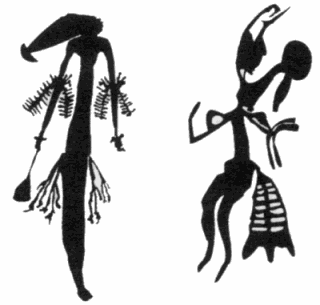 |
Science Frontiers ONLINE No. 136: JUL-AUG 2001 |
|
|
Were The First Americans Australians?
Perhaps so, perhaps no. Conceivably some venturesome Australian seafarers could have island-hopped across the South Pacific or taken a polar route (as the Vikings did in the north) when the world was warmer. Radical as this notion seems, three classes of evidence hint that Australians may have set foot on South American shores more than 10,000 years ago.
- Human fossils. As revealed in SF#118, an 11,500-year-old human skull found in Brazil possesses features of South Sea Islanders rather than Asians.
- Stone artifacts. Scrapers and other simple stone artifacts from Los Toldos Cave in Patagonia, dated as 12,000 years old, are suspiciously similar to late-Pleistocene tools in Australia. (Ref. 1)
- Cave paintings. At Los Toldos and especially another Patagonian site called Estancia La Maria, there is distinctive artwork virtually identical to some from Australia. Specifically, this artwork consists of "hand negatives" (silhouettes of the artists' hands) and spiral and circular drawings composed of little spots. (Ref. 1)
Additionally, a remarkable and entirely distinct form of Australian art -- the famous Bradshaw paintings -- are strangely echoed in the artwork of the Paracus Culture of Peru. (Ref. 2)
 Two curiously adorned flowing figures from a Bradshaw gallery, Australia |
It is relevant in the above context that one of the Bradshaw paintings depicts a boat with upright prow and stern and which is manned by many paddlers. The Bradshaw people obviously were familiar with the sea.
No one seems to know when the Brad shaw Culture flourished in Australia or where it came from. It disappeared suddenly, leaving behind perhaps 100,000 Bradshaw "art galleries" decorating rock overhangs along Australian rivers. (Ref. 2)
References
Ref. 1. Cardich, Augusto; "The First Americans: Were They Australians?" The Mammoth Trumpet, 16:4, March 2001. Cr. C. Davant.
Ref. 2. Coukell, Allan; "Spellbound," New Scientist, p. 34, May 19, 2001. Comments. We have already briefly discussed Australia's "mystery race" that was responsible for the highly anomalous Bradshaw paintings in SF#117.
An early Australian cultural beachhead in South America is, of course, relevant to the preceding "pyramid" item.
Other Sites of Interest
|